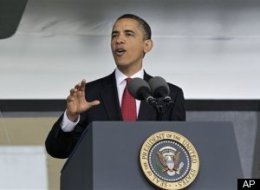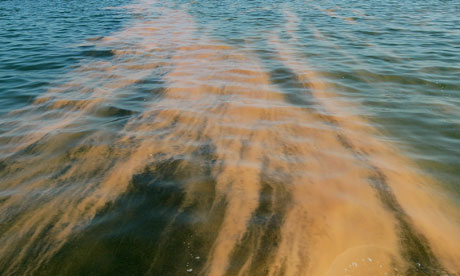We should never again allow deepwater drilling until (a) there is an adequate governmental response available in terms of expertise and equipment; and (b) there is no cap whatsoever on the liability of the oil companies should a disaster such as this occur.
My heart bleeds for the Gulf and surrounding lands - I hope that BP is still paying for this in thirty years' time, because the environmental effects will last easily that long.
Obama To Aides: 'Plug The Damn Hole'
AP/Huffington Post First Posted: 05-25-10 10:47 AM | Updated: 05-25-10 11:35 AM
WHAT'S YOUR REACTION?
Read More: Barack Obama, Bp, Gulf Oil Leak, Gulf Oil Spill, Obama Bp, Obama Gulf Oil Leak, Obama Gulf Oil Spill, Green News
WASHINGTON (AP) -- Oil spill frustration is rampant.
The White House is being pounded for not acting more aggressively in the month-old oil spill disaster in the Gulf of Mexico. The administration is hitting back, mostly at BP. Louisiana is threatening to take matters into its own hands. The truth is, the government has little direct experience at either the national or state level at stopping deepwater oil leaks - and few realistic options.
With the oil flowing and spreading at a furious rate, President Barack Obama has accused BP of a "breakdown of responsibility." He named a special independent commission to review what happened.
But the administration seems to want to have it both ways - insisting it's in charge while also insisting that BP do the heavy lifting. The White House is arguing that government officials aren't just watching from the sidelines, but also acknowledging there's just so much the government can do directly.
"[T]o those tasked with keeping the president apprised of the disaster," the Washington Postreported, "Obama's clenched jaw is becoming an increasingly familiar sight. During one of those sessions in the Oval Office the first week after the spill, a president who rarely vents his frustration cut his aides short, according to one who was there. 'Plug the damn hole,' Obama told them."
"They are 5,000 feet down. BP or the private sector alone have the means to deal with that problem down there. It's not government equipment that is going to be used to do that," Coast Guard Commandant Thad Allen told a White House briefing on Monday.
"They are the responsible party. But we have the authority to direct them," he added.
There are political risks both ways. If the federal government took control somehow, it would own the problem and any failure would belong to Obama.
But the flip side is that Obama could suffer politically if his administration is seen as falling short of staying on top of the problem or not working hard to find a solution.
In the past, the government has turned to oil industry experts to deal with oil disasters.
It famously recruited legendary oil well fighters Paul N. "Red" Adair and Edward "Coots" Matthews to help in the first Iraq war. Retreating Iraqi troops deliberately spilled 462 million gallons of oil into the Persian Gulf and set more than 700 oilfield fires.
After the 1989 Exxon Valdez oil spill in Alaska, Congress dictated in the 1990 Oil Pollution Act that oil companies be responsible for dealing with major accidents - including paying for all cleanup - with oversight by federal agencies.
That has pretty much been the model ever since. And the administration insists that's exactly what it is doing - although clearly not everyone agrees.
Anger grows as the slick spreads and washes ashore into environmentally sensitive marshes and waterways. Nerves are frayed and finger-pointing in full swing.
The administration says it is losing patience with BP PLC's efforts.
"If we find they're not doing what they're supposed to be doing, we'll push them out of the way appropriately," Interior Secretary Ken Salazar told reporters outside BP's headquarters in Houston on Sunday.
Just what did Salazar mean by "push them out of the way"? Officials have struggled since in explaining.
"That's more of a metaphor," the Coast Guard's Allen said Monday. "'Push BP out of the way' would raise the question - replace them with what?"
Allen, responsible for oversight of the spill response, said he's frustrated too, along with other Americans.
Salazar and Homeland Security Secretary Janet Napolitano led a Senate delegation to the region Monday.
"We are going to stay on this and stay on BP until this gets done and it gets done the right way," Napolitano said after flying over the affected area.
Louisiana Gov. Bobby Jindal, a Republican, has taken swipes at BP and other oil companies involved in the disaster as well as the federal government. Jindal said he was going to call out members of the Louisiana National Guard to join state wildlife and fisheries agents to supplement a federal response he called inadequate.
In particular, Jindal assailed the U.S. Army Corps of Engineers for failing to sign off on a plan to build a chain of protective sand barriers - or berms - off the coast to help block the oil.
"We are not waiting for them. We are going to build it" ourselves, Jindal said. U.S. officials say the Corps is nearing a final decision.
The spill began April 20 after the Deepwater Horizon rig owned by driller Transocean and leased by BP exploded, killing 11 workers. Millions of gallons of oil have spewed from the blown well.
Doug Suttles, chief operating officer at BP PLC, made the round of network news shows Monday with the same message: "We are doing everything we can, everything I know." He said the energy giant, formerly known as British Petroleum, understands and shares everyone's frustration.
But history isn't encouraging when it comes to underwater ruptures.
The last major spill in the Gulf was in June 1979, when an offshore drilling rig in Mexican waters - the Ixtoc I - blew up, releasing 140 million gallons of oil. The well was owned by Mexico's state oil company, known as Pemex. It took Pemex and a series of U.S. contractors nearly nine months to cap the well, and a great deal of the oil contaminated Mexican and U.S. waters.
If patience is necessary, it isn't a particularly forthcoming quality in these tense times.
Even as strong an Obama ally as Democratic consultant James Carville has been taking shots at the administration.
A Louisiana native, Carville told CNN the administration was "risking everything by this 'go along with BP' strategy. ... If you let BP handle it ... it's not going to go away. It is a disaster of the first magnitude and they've got to go to Plan B."
But so far, there was no Plan B on the table short of waiting until August, when two relief wells are expected to reach the oil deep under the ocean floor.








